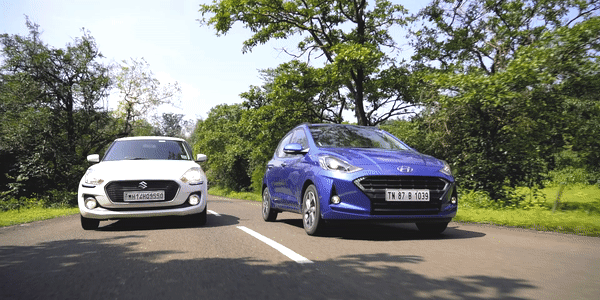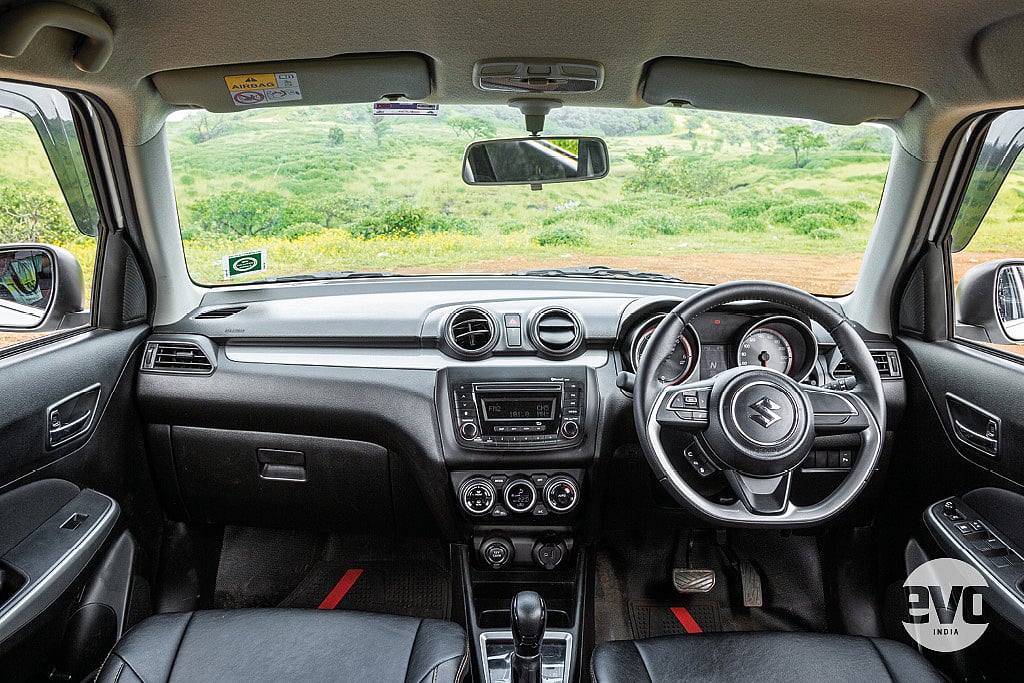Hyundai i10 Nios v Maruti Suzuki Swift: Diesel comparison test
Hyundai has aimed the i10 gun at the premium hatchback segment with the NIOS but is it any good?
 Head to Head
Head to HeadThe Swift has been the default hatchback in its class, people buying it have always got it because of its reliability, well proportioned looks and a sorted dynamics. While, the i10 has always competed in a segment below the Swift, it was more compact, had lesser power and lacked some of the gizmos too. In 2019, Hyundai decided to launch the Nios in India and instead of replacing the Grand i10, it has priced it slightly higher and given it a long feature list with an equally long name.
 Head to Head
Head to HeadWe were driving the Hyundai Grand i10 Nios in the top-spec Asta U2 trim paired to the 1.2-litre diesel with a five-speed manual, and the Suzuki Swift was in ZDI guise with the 1.3-litre diesel and an AMT gearbox. The Swift was launched last year and established itself as a great product for the enthusiast and commuter alike, and racked up a fair few awards on the way as well. The Nios, meanwhile, builds on everything that the Grand i10 has to offer and takes the fight properly to the Swift. Here they are, going head to head, to see which one comes out on top.
Styling
I will start by saying looks can be subjective — what might look good to me may not appeal to you, and that’s just how it is. So if you keep the subjective bits aside, in terms of dimensions, the wheelbases of the two cars are identical, while the Swift is both longer and wider. The Nios, meanwhile is slightly taller. The Nios rides slightly higher than the Swift and looks more compact too. The Swift looks low, has a nice squat to it and looks poised to take on some corners whereas the Nios has a hint of tall-boy stance to it.
 Alpha Blue
Alpha BlueThe rest of the details are a different story and on a closer look the Nios starts to reveal subtle details that add up to a more premium look compared to the Swift. The boomerang shaped LED DRLs on the far ends of the grille give it a signature face that you won’t mistake for any other car, a neat touch I think. The creases and lines across the car accumulate to give the Nios a very handsome and well-proportioned appearance even the faux diffuser on the rear is done well. The grille is black and not chrome, its not trying to be blingy. It looks fresh and current, while the Swift has started to age slightly. The car we are driving doesn't have the projector lamps from the ZDi+ and this makes the Swift look a bit dull. Hyundai has also given the Grand i10 Nios a really great set of colour options, something you don’t talk about often in this segment. Aqua Teal looks absolutely brilliant on the car and so does the Alpha Blue we had on our test car. The Nios definitely takes the cake on styling for us, however that may not be the case for you. So, let's quickly move onto the next segment.
Interior & Features
Before we get to the differences, I want to add that both these cars get loads of features. Hatchbacks have come a long long way and some of the features you see in these two cars were only available on premium luxury cars a few years ago, it’s great!
 Dashboard
DashboardThe Swift we had for our test was the ZDI AMT trim while the Nios was in top-spec Asta U2 trim. The Swift gets a ZDI+ variant but that is priced higher than a similarly-specced NIOS by almost Rs 40,000.
In terms of safety both cars get dual airbags for the driver and passenger as well as ABS and EBD. The pair get keyless entry and go with a push button start. There is also automatic climate control on these two and Apple Carplay/Android Auto, although on the Swift it is available only on the top spec ZDI+ variant. The ZDI also misses out on some other features too as compared to the ZDI+, like the projector headlights with LED DRLs. The Nios also gets wireless charging which is a feature that is now becoming commonplace in Hyundai's cars.
 Infotainment System
Infotainment SystemTwo sides of the same coin then? Not exactly. The Nios scores on stuff you can’t quantify, the whole cabin has an air of class around it, the material quality is one of the best I’ve seen in a hatchback. The grey seat fabric coupled with the light-coloured dash looks great and brings a very airy and light feeling to the cabin. The Swift on the other hand suffers in terms of plastic quality, the buttons don’t feel as well damped and the interior just looks dated, while the Nios has an analogue tacho with a digital speedo and trip readouts, the Swift retains two analogue dials with a digital information screen in the middle. The two are almost equally matched on rear seat space but the Nios does have better headroom thanks to that taller stance.
Driving & Dynamics
The Swift is powered by a 1.3-litre diesel engine making 74bhp and 190Nm of torque while the i10 Nios gets a 1.2-litre diesel making almost exactly the same figures at 74bhp and 190Nm of torque, more similarities then? Hyundai has clearly benchmarked the Swift, and the numbers make it evident.
 1.2-litre diesel engine
1.2-litre diesel engineHowever, once again, all is not what it seems on paper. Driving dynamics is the Swift’s territory, it has been its USP of sorts. So when the Swift underwent a major refresh for the current generation and lost the hydraulic steering rack, to make way for an electrically assisted one, enthusiasts were saddened. The last of the fun to drive hatches was fun no more, or was it? Yes, the new generation Swift's steering feel is a bit lacking compared to the previous generation cars, which was rather direct. That said, the Swift is still a driver's car. The new platform is light and while the steering is not as dialed in as before, it is still quick to turn the car in. The suspension has a bit of roll, but it is progressive and allows you to play with the weight of the car. The Swift has the wider track of the two, and is also lower and this contributes to it feeling far more sure-footed around bends than the Nios. The Nios, on the other hand, is a little more upright which spoils its handling when pushing hard but it’s not bad enough to be a deal-breaker. The steering is vague but unless you're chasing The Thrill of Driving, it will not matter, and it is actually better for maneuvering tight spots in the city. The ride quality of the Nios is a highlight though. It rides supremely well over bumps and broken road, does not break composure and there are no rattles or squeaks coming into the cabin, it was almost shocking.
Both cars have identical power and torque figures but how that plays out in the real world is fairly different. The Swift seems more urgent to get up and go, it has a sharper throttle response. The Nios, meanwhile, is more at home at lower revs, pulling along nicely using that low end torque.
The Nios is very refined, there is almost no noise coming into the cabin unless you rev the car hard and then there is an audible diesel clatter as is to be expected. The Swift is refined too but the engine is definitely noisier and the insulation is not as good the Nios.
 Gear stick
Gear stickThe Swift we had on test was an AMT but I have driven the manual Swift extensively and it has a smooth and slick gearshift, it's the perfect companion on a winding section of road. The Nios’ gearbox does not feel like it likes fast shifts, the throws are short but it does not slot in as smoothly as the Swift. When not driving spiritedly though, both cars have solid five-speed ‘boxes.
 Alloy Wheels
Alloy WheelsVerdict
Head to head, the Swift and the Nios seem to have their own departments in which they shine. The Nios has the larger share of features, the diesel is adequate to get you moving along nicely and the ride comfort and cabin quality make you feel like you’re in a hatchback a segment higher than this. The Swift redeems itself in terms of driving dynamics and power delivery but it is just not enough to put a chink in the Nios’ armour. We drove the Swift ZDI AMT which is priced at Rs 8.04 lakh while the top-spec Hyundai i10 Nios Asta U2 comes in at Rs 7.99 lakh making then similarly priced. However, the ZDI+ manual, which is similarly equipped to the top-end Nios, is priced slightly higher at Rs 8.4 lakh. The Nios is the logical choice then, Hyundai has put the right kit into the car and priced it well. It does everything you ask of it, and does it well. However, if you are someone who prioritises the driving experience over everything else and love having a fun car to drive, the Swift is still the way to go.


